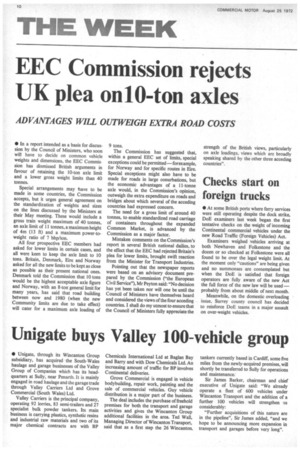EEC Commission rejects UK plea on10-ton axles
Page 12

If you've noticed an error in this article please click here to report it so we can fix it.
ADVANTAGES WILL OUTWEIGH EXTRA ROAD COSTS
• In a report intended as a basis for discussion by the Council of Ministers, who soon will have to decide on common vehicle weights and dimensions, the EEC Commission has dismissed British arguments in favour of retaining the 10-ton axle limit and a lower gross weight limits than 40 tonnes.
Special arrangements may have to be made in some countries, the Commission accepts, but it urges general agreement on the standardization of weights and sizes on the lines discussed by the Ministers at their May meeting. These would include a gross train weight maximum of 40 tonnes, an axle limit of 11 tonnes, a maximum height of 4m (13 ft) and a maximum power-toweight ratio of 7 bhp/ton.
All four prospective EEC members had asked for lower limits in certain cases, and all were keen to keep the axle limit to 10 tons. Britain, Denmark, Eire and Norway asked for all the new limits to be kept as close as possible as their present national ones. Denmark told the Commission that 10 tons would be the highest acceptable axle figure and Norway, with an 8-ton general limit for many years, has said that road building between now and 1980 (when the new Community limits are due to take effect) will cater for a maximum axle loading of 9 tons.
The Commission has suggested that, within a general EEC set of limits, special exceptions could be permitted—forexample, for Norway and for specific routes in Eire. Special exceptions might also have to be made for roads in large conurbations, but the economic advantages of a 11-tonne axle would, in the Commission's opinion, outweigh the extra expenditure on roads and bridges about which several of the acceding countries had expressed concern.
The need for a gross limit of around 40 tonnes, to enable standardized road carriage of containers throughout the expanded Common Market, is advanced by the Commission as a major factor.
Mistaken comments on the Commission's report in several British national dailies, to the effect that the EEC had rejected Britain's plea for lower limits, brought swift reaction from the Minister for Transport Industries.
Pointing out that the newspaper reports were based on an advisory document prepared by the Commission ("the European Civil Service"), Mr Peyton said: "No decision has yet been taken nor will one be until the Council of Ministers have themselves heard and considered the views of the four acceding countries. I shall do my utmost to ensure that the Council of Ministers fully appreciate the strength of the British views, particularly on axle loadings, views which are broadly speaking shared by the other three acceding countries".
Checks start on foreign trucks
• At some British ports where ferry services were still operating despite the dock strike, DoE examiners last week began the first tentative checks on the weight of incoming Continental commercial vehicles under the new Road Traffic (Foreign Vehicles) Act.
Examiners weighed vehicles arriving at both Newhaven and Folkestone and the dozen or so checked at Folkestone were all found to be over the legal weight limit. At the moment only "cautions" are being given and no summonses are contemplated but when the DoE is satisfied that foreign operators are fully aware of the new Act the full force of the new law will be used — probably from about middle of next month.
Meanwhile, on the domestic overloading issue. Surrey county council has decided to reinforce DoE teams in a major assault on over-weight vehicles.




















































































